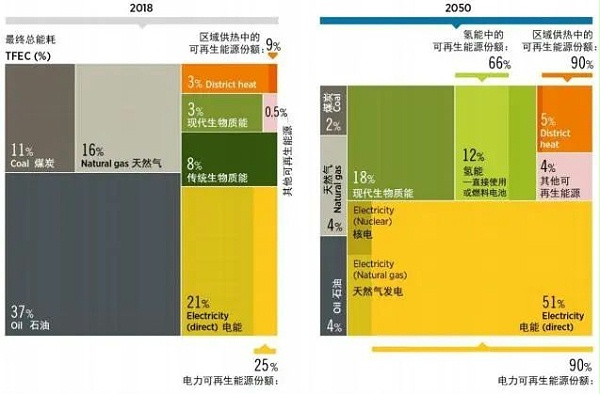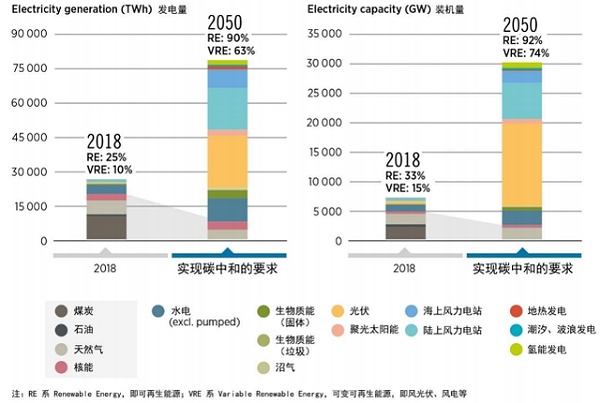以生产型企业为例,它们往往是高能耗的单位,适逢用电高峰期,用电问题是他们面对的头等大事,加上这几年国家号召节能减排,为了保证产生,一些企业往往会自发的建设备用应急电源,用来弥补用电高峰时电力不足的问题。 光伏发电是一种取之不尽用之不竭的新能源,这几年也得到国家层面的大力支持与推动,从集中式电站到分布式电站,国家出台了一系列细则与补贴办法,企业与个人对于光伏发电的认知也有了更大的改变。
目前光伏电站主要有两类应用,一种是大型地面电站,主要分布在西北人迹稀少的地方;其次就是分布式光伏电站,比如家庭屋顶、工商业屋顶、渔光互补等,而工商业屋顶作为分布式光伏电站的重要应用市场,现在也被推到很高的层面。企业厂房通常具有 屋顶面积大、屋面平整,遮挡物少,自身用电量大,电价高等特点,非常适合安装自发自用为主的光伏发电系统。 工商业光伏电站不受资源分布地域的限制,利用建筑屋面闲置资源,无噪声,无污染。
光伏电站建设于厂房之上,在一定程度上起到降温的效果,在夏季尤为明显,通常情况下可使车间降低3-6度,对于从事生产劳作的工人来说无疑改善了工作环境,对于企业来讲也降低了降温所产
碳中和”大背景下,全球光伏产业发展潜力巨大
随着工业的发展和人类活动规模的扩大,对化石能源和自然资源的过度开发利用导致温室气体排放显著增长;根据联合国《2021 年排放差距报告》显示,2021 年全球二氧化碳排放量将出现强劲反弹,化石能源二氧化碳排放量可能增长 4.8%。温室气体的过量排放将导致全球升温并引发热浪、洪水、干旱、海平面上升等一系列自然灾害,积极应对碳排放问题已成为全球共识。减少碳排放最有效的途径就是提高非石化能源的消费比例,截至 2020 年末,全球已有超过 130 个国家制定了可再生能源发展目标,有近 40 个国家设立了“碳中和”的目标;美国、欧盟、英国、日本等主要发达经济体均承诺在 2050年前实现“碳中和”。
根据 IRENA 预测,在全球 2050 年实现碳中和的背景下,到 2050 年电力将成为最主要的终端能源消费形式,占比达 51%。其中,90%的电力由可再生能源发电供应。
数据来源:《World Energy Transitions Outlook》,IRENA,2021.10
其中,光伏作为目前资源最易得、性价比最高的可再生清洁能源,肩负在碳中和时代,成为全球主力能源的重任。根据 IRENA 预测,2050 年全球光伏累计装机量将达到 14,000GW。以 2021 年全球光伏累计装机量约为 850GW 测算,增长空间达到 16.5 倍,成长确定性高。

数据来源:《World Energy Transitions Outlook》,IRENA,2021.10
而从短期来看,2022 年,在光伏发电成本持续下降和全球绿色复苏等有利因素的推动下,全球光伏市场将继续维持快速增长趋势。根据中国光伏行业协会预计,“十四五”期间全球每年新增光伏装机约 232-286GW。
特别声明:星火太阳能转载其他网站内容,出于传递更多信息而非盈利之目的,同时并不代表赞成其观点或证实其描述,内容仅供参考。版权归原作者所有,若有侵权,请联系我们删除。
Nowadays, some companies are no longer as skeptical about building rooftop photovoltaic power plants as they used to be. Smart energy use and cost saving have always been highly valued.
Taking production-oriented enterprises as an example, they are often high energy consuming units, and during peak electricity consumption periods, electricity consumption issues are their top priority. In addition, in recent years,
the country has called for energy conservation and emission reduction. In order to ensure production, some enterprises often spontaneously build backup emergency power sources to compensate for the shortage of electricity during peak electricity
consumption. Photovoltaic power generation is an inexhaustible new energy source that has received strong support and promotion from the national level in recent years. From centralized power stations to distributed power stations, the
country has introduced a series of detailed rules and subsidy measures, and the understanding of photovoltaic power generation by enterprises and individuals has also undergone greater changes.
At present, there are two main types of applications for photovoltaic power plants. One is large-scale ground power plants, mainly distributed in sparsely populated areas in the northwest; Secondly, there are distributed photovoltaic
power stations, such as home roofs, industrial and commercial roofs, and complementary fishing and lighting. As an important application market for distributed photovoltaic power stations, industrial and commercial roofs are now being
pushed to a very high level. Enterprise factories typically have large roof areas, flat roofs, few obstructions, high electricity consumption, and high electricity prices, making them very suitable for installing photovoltaic power generation
systems primarily for self use. Industrial and commercial photovoltaic power stations are not limited by the geographical distribution of resources, utilizing idle resources on building roofs, without noise and pollution.
Four Benefits of Industrial and Commercial Roof Photovoltaics
Revitalizing fixed assets and reducing electricity expenses for enterprises will benefit them for at least 20 years
Building photovoltaic power plants on the roof of enterprises is a one-time investment for enterprises, with stable returns every day. Everyone knows that industrial and commercial electricity costs are much higher than civilian
electricity, and the annual electricity expenditure is not cheap. After the installation of photovoltaic power generation, achieving spontaneous self use and surplus electricity connected to the grid can not only reduce electricity costs,
but also enjoy national subsidies for photovoltaic power generation.
02 Reduce enterprise energy consumption and alleviate electricity shortages.
For production oriented enterprises, energy consumption issues have always existed, especially during peak electricity consumption periods. Enterprises have adopted various power generation systems to supplement, but the investment
is high and the output is low. So, many companies choose photovoltaic power generation because the investment cost is relatively low, the power generation is relatively stable, and the photovoltaic power generation time is basically consistent
with the peak electricity consumption period of the enterprise, truly achieving peak shaving effect.
03 Energy conservation and emission reduction, improving the environment, and enhancing the corporate social image
After installing photovoltaic power plants on the roof of enterprises, the comprehensive utilization of solar energy and buildings is achieved, which not only achieves the effect of energy conservation and emission reduction, but
also fulfills the social responsibility of improving the surrounding environment, increasing reputation.
04 Heat insulation and cooling to improve employee work environment
The construction of photovoltaic power plants on top of the factory building has a certain degree of cooling effect, especially in summer. Usually, it can reduce the workshop temperature by 3-6 degrees, which undoubtedly improves
the working environment for workers engaged in production work and reduces the electricity cost incurred by cooling for enterprises.
Against the backdrop of "carbon neutrality", the global photovoltaic industry has enormous potential for development
With the development of industry and the expansion of human activities, the Overexploitation of fossil energy and natural resources has led to a significant increase in greenhouse gas emissions; According to the United Nations'
2021 Emission Gap Report, global carbon dioxide emissions will experience a strong rebound in 2021, with fossil energy carbon dioxide emissions likely to increase by 4.8%. Excessive emissions of greenhouse gases will lead to global warming
and trigger a series of natural disasters such as heatwaves, floods, droughts, and rising sea levels. Actively addressing carbon emissions has become a global consensus.
The most effective way to reduce carbon emissions is to increase the proportion of non petrochemical energy consumption. As of the end of 2020, more than 130 countries worldwide have set renewable energy development goals, and nearly 40 countries have
set "carbon neutrality" goals; Major developed economies such as the United States, the European Union, the United Kingdom, and Japan have all pledged to achieve "carbon neutrality" by 2050.
According to IRENA's prediction,
in the context of achieving carbon neutrality globally by 2050, electricity will become the main form of terminal energy consumption, accounting for 51%. Among them, 90% of the electricity is supplied by renewable energy generation.
Among them, photovoltaic, as the most easily available and cost-effective renewable clean energy, shoulders the responsibility of becoming the global main energy source in the era of carbon neutrality. According to IRENA's prediction,
the cumulative installed capacity of global photovoltaics will reach 14000GW by 2050. Based on the global cumulative photovoltaic installed capacity of approximately 850GW in 2021, the growth potential is 16.5 times higher, indicating
high growth certainty.
Special statement: Starfire Solar's reposting of other website content is for the purpose of conveying more information rather than profit, and does not necessarily endorse its views or confirm its description. The content is for
reference only. The copyright belongs to the original author. If there is any infringement, please contact us to delete it.